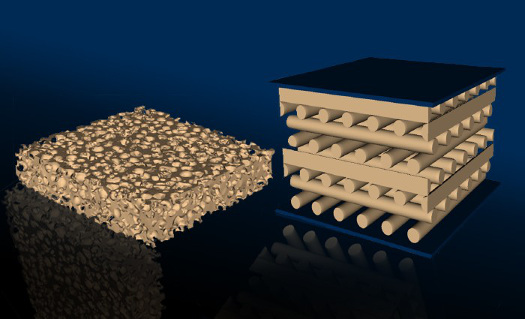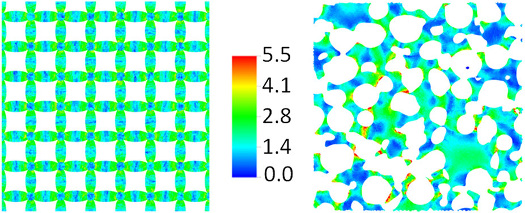 |
| May 24, 2016 | Volume 12 Issue 20 |
Designfax weekly eMagazine
Archives
Partners
Manufacturing Center
Product Spotlight
Modern Applications News
Metalworking Ideas For
Today's Job Shops
Tooling and Production
Strategies for large
metalworking plants
National Lab: 3D-printed foam outperforms standard materials
Lawrence Livermore National Laboratory (LLNL) material scientists have found that 3D-printed foam -- featuring uniform structures with well-defined cellular shapes and dimensions, even down to the microscale level -- works better than standard cellular materials in terms of durability and long-term mechanical performance.
Foams, also known as cellular solids, are an important class of materials with applications ranging from thermal insulation and shock-absorbing support cushions to lightweight structural and floatation components. Such material is an essential component in a large number of industries, including automotive, aerospace, electronics, marine, biomedical, packaging, and defense. Traditionally, foams are created by processes that lead to a highly non-uniform structure with significant dispersion in size, shape, thickness, connectedness, and topology of its constituent cells.

Microstructures of two different foam materials. At left, a traditional open-cell stochastic foam. At right, a 3D-printed foam with a face-centered tetragonal lattice structure.
As an improved alternative, scientists at the additive manufacturing lab at LLNL recently demonstrated the feasibility of 3D printing uniform foam structures through a process called direct-ink-write. However, since 3D printing requires the use of polymers of certain properties, it is important to understand the long-term mechanical stability of such printed materials before they can be commercialized. This is especially vital in applications such as support cushions, where the foam material is subjected to long-term mechanical stresses.
To address the stability question, the LLNL team performed accelerated aging experiments in which samples of both traditional stochastic foam and 3D-printed materials were subjected to a set of elevated temperatures under constant compressive strain. The stress condition, mechanical response, and permanent structural deformation of each sample were monitored for a period of one year and, in some cases, even longer. A method called time-temperature-superposition was then used to quantitatively model the evolution of such properties over a period of decades under ambient conditions.

Stress distribution in a typical slice of AM FCT foam (left) and stochastic foam (right), both under 15 percent compressive strain. The presence of many high stress points is clearly evident in the stochastic foam. The presence of these high-stress points over an extended period of time is likely responsible for higher compression set and lower load retention in the stochastic foam as compared to the AM FCT foam. The stress scale bar is in units of 105 Pa.
This study convincingly demonstrated that 3D-printed materials age slowly (i.e., they retain their mechanical and structural characteristics better) as compared to their traditional counterparts. Interestingly, native rubber (i.e., elastomer) comprising each foam showed exactly the opposite effect (i.e., the rubber in the printed material aged faster than the corresponding rubber used in the traditional foam).
To gain further insight into why the printed cellular material displayed superior long-term stability, the team imaged the 3D microstructure of each foam sample with X-ray computed tomography and performed finite-element analysis of the stress distribution within each microstructure. They found that there is a much wider variation in local stresses within the stochastic foam, with points of extreme stress significantly higher than the maximum stress points within the more uniform 3D-printed foam.
The research appears in the April 27 edition of the journal Scientific Reports.
"3D printing of foams offers tremendous flexibility in creating programmable architectures, customizable shapes, and tunable mechanical response," said lead author Amitesh Maiti. "Now that our work strongly indicates superior long-term stability and performance of the printed material, there is no reason not to consider replacing traditional foam with appropriately designed 3D-printed foam in specific future applications."
Other Livermore co-authors include Ward Small, James Lewicki, Todd Weisgraber, Eric Duoss, Sarah Chinn, Mark Pearson, Christopher Spadaccini, Robert Maxwell, and Thomas Wilson.
The group also acknowledges contributions from the National Security Campus, Missouri (formerly Kansas City Plant) where some of the early aging experiments were performed.
Source: Lawrence Livermore National Laboratory
Published May 2016
Rate this article
View our terms of use and privacy policy
